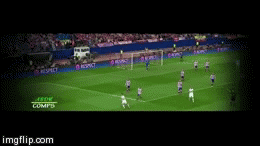Starting Position
In the GIF below, we see the ball played from the corner of the 18 diagonally forward toward the corner flag. Because the ball is played outside the width of the 18, and well below the penalty spot (ie: less than 12 yards from the goal line) there is very little chance of a shot at goal being taken, and if one were taken, infinitesimally small odds of it beating a GK:
So the issue clearly is that the GK is very tight to the near stick, and when the cross comes in, he can barely put a finger to the ball. No harm comes immediately, but the next level will see a better ball played in, and better runs from the target players to get on the cross. The conservative starting position, most importantly, costs the team a corner kick, and a dangerous set-piece situation (30-40% of all goals come from set peices!) So what could be an easy catch and a chance to counter attack (we can see at least 4 dark shirts inside the 18 so 6 still back covering, but there may be a counter on with good distribution) has now become additional danger.
It's thinking too small to say that the danger was avoided, even if temporarily, when a more aggressive starting position could have turned the tables completely and created another cause of sleepless nights for coaches, a counter attack. Little moments like this make and break careers, seasons, and separate the best from the rest. The good news is that for this particular player, if he can work with good coaching, and take criticism, study his job and put in the time and focus on the training ground, he can easily make this play into something advantageous for his squad.
By way of contrast, here are two pretty good GKs, Keylor Navas and Fernando Muslera in similar situations...for my preferences, I like Meusler's approach a bit better:
Navas first (full video here):
Here's Fernando (full video here):





